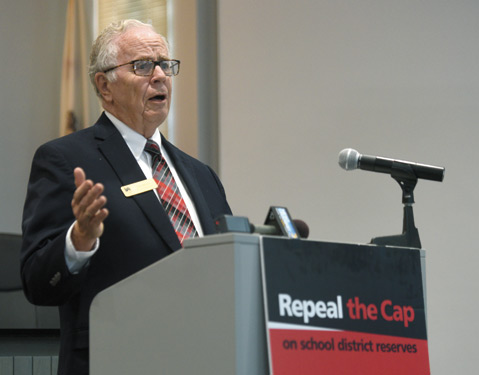Schools Oppose Cap on Rainy-Day Savings

Renewed opposition to SB 858 — a year-old bill that limits how much California schools can sock away for a rainy day — filled the Santa Barbara Unified School District administration building last week as representatives from districts in Santa Barbara, Ventura, and San Luis Obispo counties spoke out against the controversial legislation. The backlash gained traction Tuesday morning in Sacramento, as Senator Jerry Hill (D-San Mateo) — backed by the California School Boards Association, the League of Women Voters, and the California PTA — introduced a legislative fix aimed at making fiduciary lemonade out of the SB 858 lemon.
SB 858 opponents explain that when rainy-day savings kick in on the state level, school districts will be required to spend any reserves above a designated cap, generally 6 percent of the total budget. Proponents, including the California Teachers Association, say that SB 858 — passed as part of the state budget last year — keeps districts from saving money that ought to be spent on students. But according to Santa Barbara’s school board president, Ed Heron, “Limiting our savings threatens classroom programs, teacher and employee jobs, and the district’s ability to save for textbooks, technology upgrades, [etc.]” Heron also pointed out that, with less money in savings, the district’s credit rating could take a hit, affecting its borrowing strength to cover payroll, for example, as income from property taxes only flows twice annually.
This district’s current reserves are a bit above 6 percent, according to Barbara Keyani, Santa Barbara Unified’s communications coordinator. “We cannot exceed 6 percent if SB 858 is triggered,” she added. Heron said that a board goal is to have 10 percent — upward of $14 million — in reserves.
While there’s no guarantee that the state will start saving — thereby triggering the districts’ savings cap — the threat remains, especially as the economy continues to improve, according to Shelly Sullivan with the California School Boards Association.
Among other details, Sen. Hill’s legislative fix — SB 799 — aims to set a maximum reserve cap at 17 percent and exempt basic-aid school districts and those with fewer than 2,501 students. SB 799 would also require district superintendents to hold public hearings during which boardmembers would craft policy based on reserves and fund balances.



